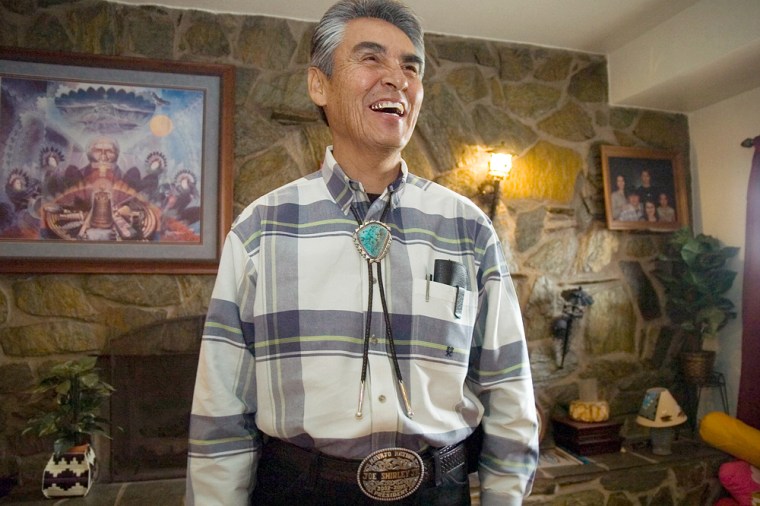All of seventh-grader Nikkolas Page's school assignments are done on the Internet.
He logs on to a computer each day at 1 p.m. at the Inscription House Chapter on the northwestern side of the Navajo Nation in Arizona, downloads his assignments, and when he's done, submits the answers online.
Twice a week, he's required to attend live sessions with other students and teachers.
The 12-year-old was in Flagstaff this past week doing standardized tests required of all Arizona public school students, but he might find his online schooling is not as easy to do this week.
The chapter house, which operates like a city government, was one of about 70 where Internet service was shuttered a week ago. OnSat Network Communications Inc., the company that had provided the service, said that's because it has not received $2.1 million in federal funds needed to pay a subcontractor for satellite time.
The Universal Service Administration Co., which administers the E-rate program, is withholding the funding because of a tribal audit that showed OnSat may have double-billed the tribe. The audit also raised questions about how the tribe requested bids for the Internet contract.
Tribal officials say it could be a couple of weeks before service is restored to chapter houses across the 27,000 square-mile reservation. They've been meeting with other Internet service providers to explore their options. Utah-based OnSat, meanwhile, has offered to reconnect the affected chapter houses, if they pay out of their own pockets.
A spokesman for Navajo President Joe Shirley Jr. has suggested that chapter houses use budget contingency money to pay for the service.
Inscription House Chapter officials say they're working quickly to restore the service.
For Page's mother, Wendy Page, sending her son to public school is not an option, and driving more than an hour into Page, Ariz., to access the Internet every day really isn't either.
"Can you imagine going 120 miles a day with our gas prices in the local area at $3.60 a gallon?" she said. "That's going to cause a big impact."
Wendy Page has two other students who attend Page High School — one of whom has been staying three hours longer so that she can access the Internet now that the chapter house's service is down.
"They don't even know what (an) encyclopedia is," Page said. "All they know is the Internet search for their homework."
The Internet shutdown also has changed plans by the Page Unified School District to deliver two computers each to five Navajo communities to help parents track their children's progress and to aid students with homework assignments.
"We were set, we had them, then all of a sudden the Navajo Nation announces they no longer have Internet capability," said Elton Loy, the Navajo community district liaison. "Once they have a plan in place, we can take those computers and we can go out and distribute those to the chapters. ... Right now they would be of little use."
The Internet service was the main reason residents of Tolani Lake visited the chapter house on the southwest side of the reservation.
"There hasn't been anybody here since it went down," office specialist Melanie Benally said.
Benally, whose chapter uses the Internet for bank transactions, budgets, to post community announcements and order office supplies, said it's "kind of sad how dependent we are on the Internet."
Benally said she doesn't mind having to pay OnSat directly for the services, "but the charges are outrageous." The quarterly rates range from $289 for one administrative computer to $699 for multiple administrative computers. The annual cost for public access computers is $4,875, according to a document OnSat sent to the chapters.
"The only thing we can afford right now is the administrative use," Benally said. "For the public use, our students who are taking online classes, they have to find another place to get online access."
At the Rock Point Chapter House, Teresa Yellowhair knew who the regular Internet users were — two men who would spend about an hour each day on the Internet, looking for job openings and checking e-mail.
On Wednesday, the men came to the chapter house and Yellowhair told them they'd have to find somewhere else to get online.
"They just rolled their eyes and they took off," she said.
Yellowhair said her chapter had not made immediate plans to restore the Internet.
Not all of the tribe's 110 chapter houses rely on OnSat for the Internet. About 40 of them have copper lines running nearby, enabling them to get Internet via a phone line. But about a dozen are more remote, and without satellite technology "are very hard to reach," said Harold Skow, director of the tribe's Department of Information Technology.
The tribe is creating a wireless grid on the reservation that is supposed to be completed within two years, but may be expedited because of the recent shutdown, Skow said.
"We just need to win support of the (Tribal) Council and get the proper funding for it and that equipment ... installed, because the engineering has been done," he said.
The wireless grid is being built from Holbrook, Ariz., to Navajo Mountain. One branch will extend from Chinle to Roof Butte — the highest point on the Chuska Mountains — and eventually connect to the eastern side of the reservation.
Another branch will run to Tuba City, said Ernest Franklin, director of the tribe's Telecommunications Regulatory Commission.
"Our goal in this whole thing is by 2010, we want to catch up to the rest of the nation," he said.
